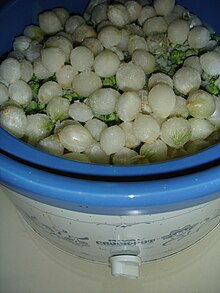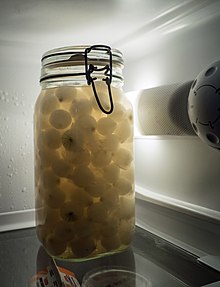| Pearl onion | |
|---|---|
 Pearl onions and peas topping a crockpot dish | |
| Species | Allium ampeloprasum var. sectivum or A. ampeloprasum 'Pearl-Onion Group' |
| Cultivar | 'Pearl onion' |
The pearl onion (Allium ampeloprasum var. sectivum or A. ampeloprasum 'Pearl-Onion Group'),[1] also known as button onion, baby onion or silverskin onion in the UK,[2] is a close relative of the leek (A. ampeloprasum var. porrum), and may be distinguished from common onions by having only a single storage leaf,[3] similar to cloves of garlic. In French they are known as oignon grelot. One English-speaking reference also mentions the term petit poireau antillais.[4]
Cultivation and storage[edit]
Pearl onions are cultivated mostly in Germany, the Netherlands, and Italy,[5] usually in home gardens,[1] although formerly on a commercial scale.[4] They are mostly used for pickling.[6]
Consumption[edit]

Because of its uniquely small size and a taste sweeter than that of a common onion,[2][7] it has also been used in dishes ranging from mid-20th-century American casserole dishes such as succotash to sweetly flavored onion relishes in Indian cuisine. It can also be used in stews soups or sautéed (fried) with other vegetables.[8][2][9] It can also be used in cocktails such as "martini standing".[5]
Pearl onions are a staple to the cuisine of Northern Europe.[citation needed] Also in modern Europe they are used as a flowering plant, and in Israel as a cut flower.[4]
Pearl onions contain chemical compounds that have health benefits including helping cardiovascular health and stabilize blood sugar levels, and acting as an antioxidant and anti-inflammatory.[10][11][better source needed]
Common onions as a substitute[edit]
The majority of onions grown for pickling are common onions (A. cepa),[12] which are normally much larger, but are grown to a small size suitable for pickling by planting them so densely that each one has very little room to grow.[13] Common onions grown in this way are often referred to as "pearl onions" even though they do not belong to the same family as true pearl onions.[5]
White varieties of common onions grown in this way for pickling include Crystal Wax[5] and White Bermuda.[7] There are red varieties as well, which are milder in flavour.[10] Common onions grown from seed to produce small bulbs for pickling are ready to harvest in 90 days.[7] In their fresh state they can be stored for up to a month in a cool, dry, dark place.[10][11]
Cultural references[edit]
Larry Wall's yearly State of the Onion speeches about advancements in Perl programming, an allusion to the many layers of the language, are named as a pun both on the pearl onion and the U.S. president's State of the Union addresses.[citation needed]
References[edit]
- ^ a b Fritsch, R.M.; N. Friesen (2002). "Chapter 1: Evolution, Domestication, and Taxonomy". In H.D. Rabinowitch and L. Currah (ed.). Allium Crop Science: Recent Advances. Wallingford, UK: CABI Publishing. p. 9. ISBN 0-85199-510-1.
- ^ a b c "Onion". waitrose.com. Retrieved 23 January 2017.
- ^ AVRDC - The World Vegetable Center. "Onion cultivation". Archived from the original on 4 March 2011. Retrieved 25 April 2011.
- ^ a b c "Parisian Onions". traveltoeat.com. 17 June 2012. Retrieved 23 January 2017.
- ^ a b c d Linda Griffith and Fred Griffith Onions, Onions, Onions: Delicious Recipes for the World's Favorite Secret ..., p. 126, at Google Books
- ^ Hanelt, Peter (2001). "Alliaceae". In P. Hanelt (ed.). Mansfeld's Encyclopedia of Agricultural and Horticultural Crops (except ornamentals). Berlin: Spring-Verlag. p. 2266. ISBN 3-540-41017-1.
- ^ a b c "Pearl Onions". cooksinfo.com. Retrieved 23 January 2017.
- ^ Pearson, Liz (21 December 2007). "SKINNING A PEARL ONION". saveur.com. Retrieved 23 January 2017.
- ^ Maister, Kathy. "How to Peel Pearl Onions". startcooking.com/. Retrieved 23 January 2017.
- ^ a b c "Pearl Onions". bonappetit.com. 6 February 2008. Retrieved 23 January 2017.
- ^ a b "Pearl onion nutrition selection storage". fruitsandveggiesmorematters.org. Retrieved 23 January 2017.
- ^ Fritsch, R.M.; N. Friesen (2002). "Chapter 1: Evolution, Domestication, and Taxonomy". In H.D. Rabinowitch and L. Currah (ed.). Allium Crop Science: Recent Advances. Wallingford, UK: CABI Publishing. p. 20. ISBN 0-85199-510-1.
- ^ Brewster, James L. (1994). Onions and other vegetable alliums (1st ed.). Wallingford, UK: CAB International. p. 212. ISBN 0-85198-753-2.
Well, that’s interesting to know that Psilotum nudum are known as whisk ferns. Psilotum nudum is the commoner species of the two. While the P. flaccidum is a rare species and is found in the tropical islands. Both the species are usually epiphytic in habit and grow upon tree ferns. These species may also be terrestrial and grow in humus or in the crevices of the rocks.
View the detailed Guide of Psilotum nudum: Detailed Study Of Psilotum Nudum (Whisk Fern), Classification, Anatomy, Reproduction